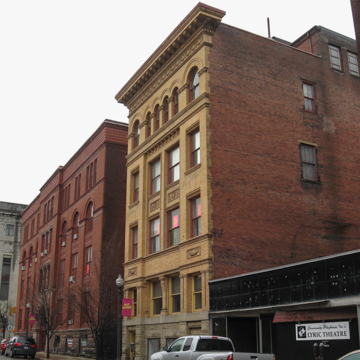You are here
Transit Fine Art Gallery (National Transit Company Building)
Enoch A. Curtis of Fredonia, New York, and his partner William Archer, about whom little is known, designed this four-story headquarters building for the National Transit Company, the oil pipeline and transportation wing of the Standard Oil Company. They apparently chose as their model Burnham and Root's Rookery Building in Chicago designed just four years earlier. Oil City's building has tripartite massing with a slightly projecting central bay highlighted by a massive, stone-arched entrance, and slightly depressed window niches covering three stories, separated by pilaster strips and capped by round arches. Distinctive ornamentation at the cornice consists of five rows of dentils on all sides of the building, with a minimal capstone above and a checkerboard brick pattern in the spandrels. The small lobby facing Seneca Street has a divided stair with an elaborate iron railing defined by newel posts. In 1896, the same architects designed an orange Pompeiian brick annex next door. This Renaissance Revival annex also has four stories of brick above a raised stone basement. An 1899 archway connects the two buildings.
Writing Credits
If SAH Archipedia has been useful to you, please consider supporting it.
SAH Archipedia tells the story of the United States through its buildings, landscapes, and cities. This freely available resource empowers the public with authoritative knowledge that deepens their understanding and appreciation of the built environment. But the Society of Architectural Historians, which created SAH Archipedia with University of Virginia Press, needs your support to maintain the high-caliber research, writing, photography, cartography, editing, design, and programming that make SAH Archipedia a trusted online resource available to all who value the history of place, heritage tourism, and learning.


